Day 4, Belfast: And finally, I am in Belfast, once the most populous and prosperous city in Ireland, now the capital of Northern Ireland.
My day started at the world’s number one tourist attraction, casual like. Once the story of Titanic, the 'unsinkable' ship, was like an illegitimate child – swept under the carpet and best not mentioned.
The city that built her had no desire to be associated with such a famous failure and it was only after the runaway success of the film that locals decided to reclaim the Queen of the Ocean as one of their own.
I’ll not lie, I really like most history museums, but Titanic Belfast was something special. The tale of the doomed passenger ship that sank on her maiden voyage is one of the most haunting of the 20th century and her story is a narrative patchwork quilt of love and loss, poverty and wealth, bravery and cowardice.

"Titanic Belfast was something special."
Our guide, Billy Scott, said people fly in from all over the world to see the museum and then leave the next day. Why they would do that when there’s so much else going on in Belfast is beyond me, but it’s also a testament to the spell that ship has cast upon our imaginations and the first-class museum that tells her story.
Next up: murals and ‘flegs’ – as they call them locally.
Read more: Day 3 – Discovering Derry, the legendary city where genius flourished with Heaney, Hume, and more
In West Belfast the bonfires were stacked and the flags were a-flying. The Twelfth of July is around the corner and it’s a day to celebrate for those in Ireland who are loyal to the Crown as it marks the victory of the Protestant King William over the Catholic King James at the Battle of the Boyne in 1690.
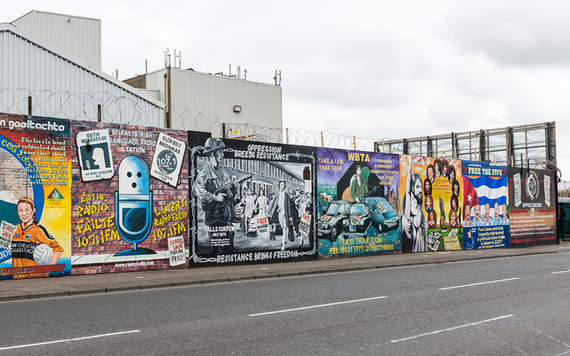
Murals on Falls Road, West Belfast.
Parts of Belfast remain as rigidly segregated as the Deep South 50 years ago and I’m not sure how serious our guide’s warning was when he told us not to cross ourselves when we get out.
In recent years government grants have encouraged people in Northern Ireland to paint over murals depicting paramilitaries and instead display more cultural images.
There’s still one of Stephen McKeag, a Commander of the Ulster Defence Association shot dead in 2000, but there’s also a nice “A-Z of the Shankill Road” and collage of Queen Elizabeth.
Progress comes in stages.
A towering wall divides a Protestant estate from their Catholic neighbors just feet away. They’re called peace-lines, but they’re much more of a symbol of conflict than of harmony.
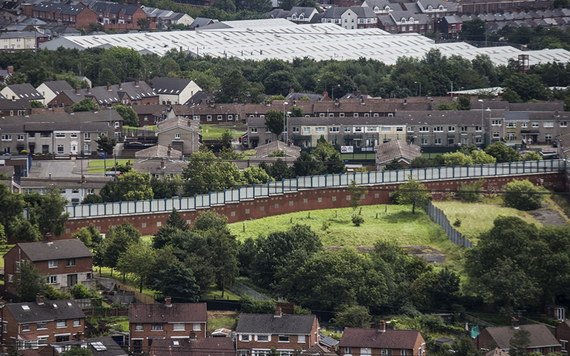
The Peace Wall dividing communities in Belfast city.
Barack Obama dropped by in 2013 and suggested he’d like to see the walls be packed away by 2023. It lacked the drama of, “Mr Gorbachev, tear down this wall!” but the sentiment was appreciated.
Still, 2023 might be a bit optimistic. Ask what lies on the other side of the wall and you might get the almost monosyllabic reply, “fear.”
But the two communities aren’t completely cut off from each other. At night time it might not be wise to cross the divide, but by day people will happily shop in each other’s shops and, of course, they are united through the use of a common National Health Service (NHS). The local hospital serves anyone who lives nearby and, like in mainland Britain, does not charge a billionaire or a pauper a penny for treatment.
The maintenance of this service, “free at the point of need,” is something of a shibboleth among all political parties in the province and it is by far Northern Ireland’s biggest employer – 70,000 locals (out of a population of 1.8 million) collect a paycheck every month from Her Majesty’s Government for working in the NHS.
“We have a very good health service,” one of the Americans I’m traveling with is jokingly assured after she almost trips. The remark might have been in jest but it was indicative of the pride people take in the 69-year-old system.
Read more: Day 2 – A journey through political divisions – from the Giant’s Causeway to Derry
No one here worries about the cost when a child gets sick or the loss of health insurance when they change jobs. Like how a free market economy is the settled will of the American people, socialized health care is the settled will of the people of this corner of Ireland – whether they be orange, green or a shade in between.
And speaking of the green folk, a large number of them live only a few streets away from Shankill on the Falls Road – the heart of republican Belfast.
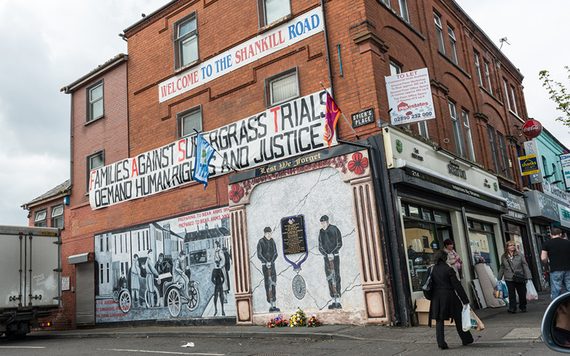
Shankill Road, Belfast.
I like the Falls Road: I love to hear the Irish language spoken anywhere, anytime and the local people have opened a cultural center where you can order a cup of tea as Gaeilge and browse through a huge collection of books in the language.
Irish speakers are clearly reading IrishCentral because they’re well abreast of current events stateside and a new novel called “Trumptaí Dumptaí agus An Falla Mór” (Trumpty Dumpty and the Big Wall) is being sold. It tells the tale of two lads from Galway who are asked by the White House to help build the President’s wall and keep out the bad hombres.
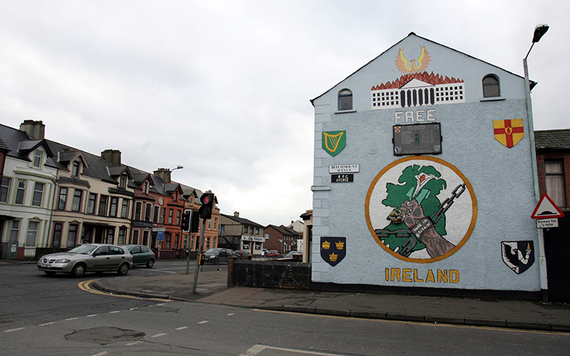
Murals in the Falls Road neighborhood, Belfast.
Down south the use of the language by officials can be a bit tokenistic. All public signage must be bilingual by law and you have the right to interact with the state through Irish but ask to talk to a civil servant through the language and you’ll often come up across a wall even more irritating than the one proposed along the Mexican border.
Here the language has few legal rights but it seems to be flourishing – even the graffiti is through Irish. The lack of official status has clearly irritated a number of teenagers and I see “Acht Gaeilge Anois” (An Irish Language Act Now) scrawled twice on walls.
Other Gaelic admonitions on the walls include, “Díchoilínigh d'intinn” (Decolonize your mind) and “Lig do Liú” (Let yourself yell).
The other thing I notice is there’s a sense of solidarity between local republicans and the LGBT community. The rainbow flag is occasionally seen flying alongside the tricolor (something I never saw in loyalist areas) and a mural commemorates the victims of the Orlando shooting alongside the leaders of the 1916 Rising.
I remember once knocking on doors two years ago in a working-class Dublin estate and not finding a single person planning on voting 'No' in the marriage equality referendum. So, I shouldn’t be surprised that the sense of solidarity and support for equality doesn’t end at Dundalk, but it’s still a pleasant sign of progress nonetheless.
Northern Ireland doesn’t have gay marriage and the issue was one of a number that led to the collapse of the province’s assembly earlier this year.
Sinn Féin wants it, the Democratic Unionist Party does not. The jaw-jaw continues but, as Winston Churchill said, that's preferable to war war.
There is, however, an upside to being a disenfranchised community: as one of Belfast’s many groups of oppressed peoples, LGBT people have the moral authority, nay divine right, to paint the kerb stones outside Belfast’s collection of gay bars in the colors of their ‘fleg’ and they do.
Sure, they can’t get married but they can at least make their home look a little better and what doesn’t look nicer when decorated in the all the colors of the rainbow?
After that we’re taken off on the city’s brilliant “Taste and Tour” trip and first up is the Mourne Seafood Bar. If you dig a little you’ll find even the local food tells the story of a place and as we’re tucking into a platter of seafood. The owner, Bob, tells us there’s never been a better time to sell fish in Ireland.
Mourne Seafood Bar, in Belfast's city center.
For so long there was stigma about seafood. When the potato crop failed in 1845 many were forced to head to the sea and fish for survival. The association with fishing and poverty endured for generations.
Since the Irish discovered cheap flights to Europe, he said, that has all changed and their exposure to seafood on the continent changed attitudes. Now people are happy to eat fish – the stigma has lifted.
If Britain strikes a poor deal with the EU over the next two years and tariffs are placed on goods traveling between north and south that would be a “disaster” for the industry, Bob says.
But not everyone is so apprehensive about Brexit. Moored not far away are a number of new trawler boats in Belfast harbor. Our guide Billy says the United Kingdom’s impending exit from the EU’s Common Fisheries Policy has seen a splurge of investment in what has long been a morose industry. The end of the CFP would mean the end of foreign trawlers fishing in British waters and industry insiders are anticipating the catch caught by boats from abroad will be reassigned to locals.
Hoteliers are happy too. The drop in the value of the pound sterling after the Brexit vote saw an influx of tourists from abroad. 12 hotels are under construction in Belfast alone and plenty more planning applications have been lodged. Taxes on hospitality are higher in the north than the in south, I’m told, but the pound’s plunge has given them a competitive advantage over the Republic at last.
In the pro-EU stronghold of Derry I saw stickers “No Brexit, No Border,” EU flags and felt a palpable sense of worry, but the further you get from the border with the Republic the more ambivalence, and even irritation, towards the European project you encounter.
One man’s difficulty is another man’s opportunity, as they say.
Now on my way to Dublin, I’m glad I got a chance to explore Northern Ireland. The way they describe everything as “wee” is endearing. “Would you like a wee drink now?” “Would you take a look at those wee sheep?”
The place is immersed in politics and history in a way I’m sure would be wearying if you lived here but for a short while it was fascinating to delve into.
My parents told me when they visited a quarter of a century ago it felt like a 1950s time warp: men wore their Sunday best to dinner, everyone went to church and children played out in the streets.
In a way it still felt like a small leap into the past. Our taxi driver wore a suit, there were few immigrants and far more local stores than big chains.
If you feel nostalgia for the late 20th century come quick. Globalization won’t ignore this corner on Europe’s western periphery forever.
As for me, I say "I’ll be back."
Read more: Day 1 – Landing in beautiful Belfast on Norwegian Air’s inaugural flight
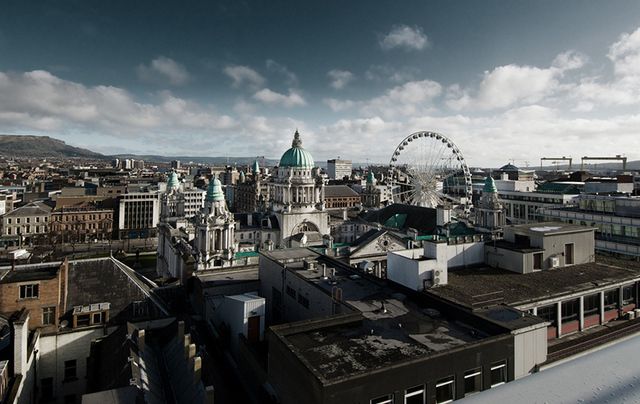


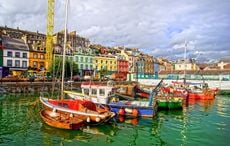
Comments